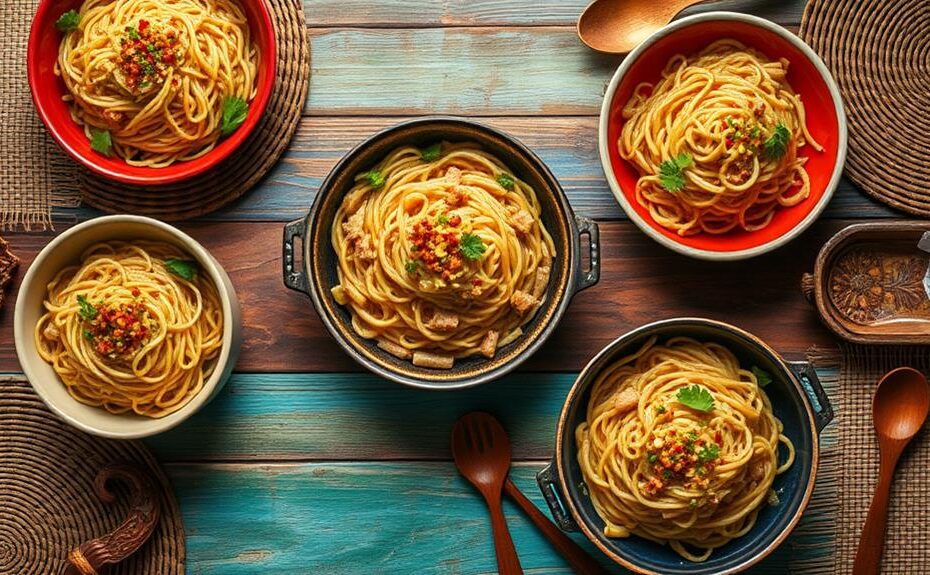Over 100 variations of Pancit Canton exist across the Philippines, each reflecting unique regional flavors, ingredients, and cooking techniques that showcase the country's cultural diversity and resourcefulness.
For instance, Ilocos' version features a tangy vinegar-based sauce, while Batangas' Pancit Lomi is heartier.
Vegetarian adaptations are also available, catering to dietary restrictions.
Additionally, regional twists like Pancit Habhab, served on banana leaves, offer new textures and flavors.
Exploring these variations reveals the rich cultural heritage and symbolism behind this beloved Filipino dish.
Exploring Filipino Pancit Canton Variations
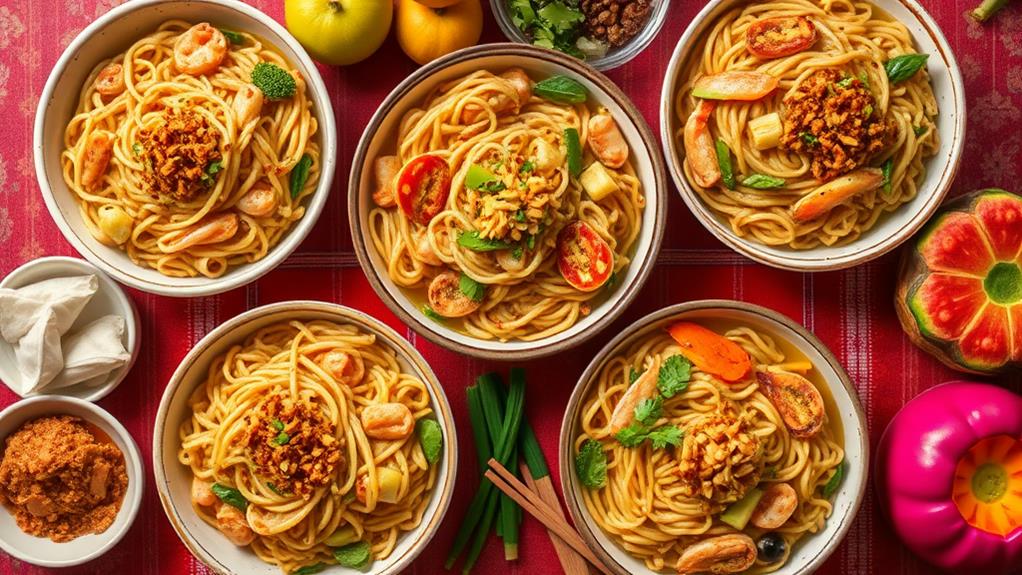
Pancit Canton's adaptability is its greatest strength, allowing each region in the Philippines to create its own unique version of this beloved dish.
Meat variations include adding seafood like shrimp or squid alongside traditional meats like pork or chicken.
Vegetable additions feature local ingredients like chayote and snow peas, adding freshness and color to the dish.
Dietary adaptations cater to vegetarian preferences by using tofu and a variety of vegetables, maintaining the characteristic savory taste.
Regional variations reflect the country's cultural diversity and resourcefulness in the kitchen.
Regional Twists on Classic Pancit Noodles
Regional Variations of Pancit Canton
Pancit Canton, a beloved Filipino dish, takes on unique forms across different regions. Each region infuses its own flavors, ingredients, and cooking techniques into this classic noodle dish.
Ilocos' Tangy Twist
In Ilocos, Pancit Canton is often served with a distinct vinegar-based sauce and incorporates local vegetables. This tangy flavor profile sets it apart from other regional variations.
Batangas' Hearty Pancit Lomi
In Batangas, Pancit Lomi features thick egg noodles served in a savory broth, making it a heartier and more filling version of the classic stir-fry.
Visayas' Fresh Flavor
In the Visayas region, Pancit Habhab is typically served on a banana leaf and garnished with vinegar, emphasizing a fresh and tangy flavor profile.
These regional twists demonstrate the versatility of Pancit Canton, a dish that can be adapted to local tastes and ingredients.
With each family having its own cherished recipe, the possibilities for different pancit and types of noodles are endless, reflecting the rich culinary traditions of the Philippines.
Understanding Cultural Significance of Pancit
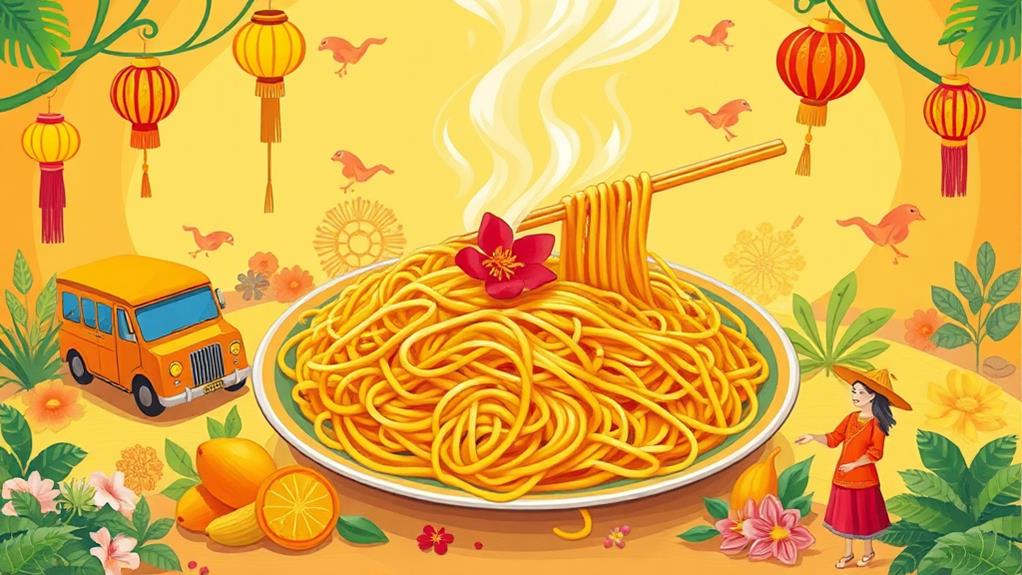
Pancit Canton: A Symbol of Longevity and Prosperity
Pancit Canton, a staple dish in Filipino culture, symbolizes longevity and prosperity during celebrations and gatherings. When sharing a plate of Pancit Canton, you're participating in a tradition that emphasizes communal sharing and hospitality.
Regional and Family Variations
Traditionally prepared with a variety of meats and vegetables, Pancit Canton showcases regional and family variations that reflect local ingredients and culinary traditions.
For example, some recipes may include ingredients like patis (fish sauce) or bagoong (fermented fish paste), which are common in Filipino cuisine.
Culinary Influences and Cultural Heritage
Pancit Canton represents the fusion of diverse culinary influences in the Philippines, including Chinese and Malay traditions.
Recipes for Pancit Canton are frequently passed down through generations, preserving cultural heritage and fostering a sense of identity and pride among Filipinos.
Experiencing Filipino Culture and History
When trying Pancit Canton, you're not just tasting a dish; you're experiencing a piece of Filipino culture and history.
Must-Try Pancit Noodle Dishes in Philippines
Pancit Canton's versatility has led to numerous variations across the Philippines, showcasing the country's diverse culinary landscape.
Different regions in the Philippines offer distinct types of Pancit Noodles, each with its unique flavor profile and cooking technique.
Pancit Malabon, a regional specialty, features thick rice noodles and a rich seafood sauce that leaves you wanting more.
Pancit Lomi, a comforting dish, is served in a savory broth with vegetables and sliced meats, making it perfect for any occasion.
Pancit Bihon, a staple in Filipino celebrations, consists of thin rice vermicelli noodles stir-fried with an array of vegetables and proteins, symbolizing longevity and prosperity.
These dishes demonstrate the country's culinary diversity and the adaptability of Pancit Canton.
Whether you're in the mood for something savory, comforting, or celebratory, there's a Pancit Noodle dish that satisfies your cravings.
Popular Ingredients and Cooking Techniques
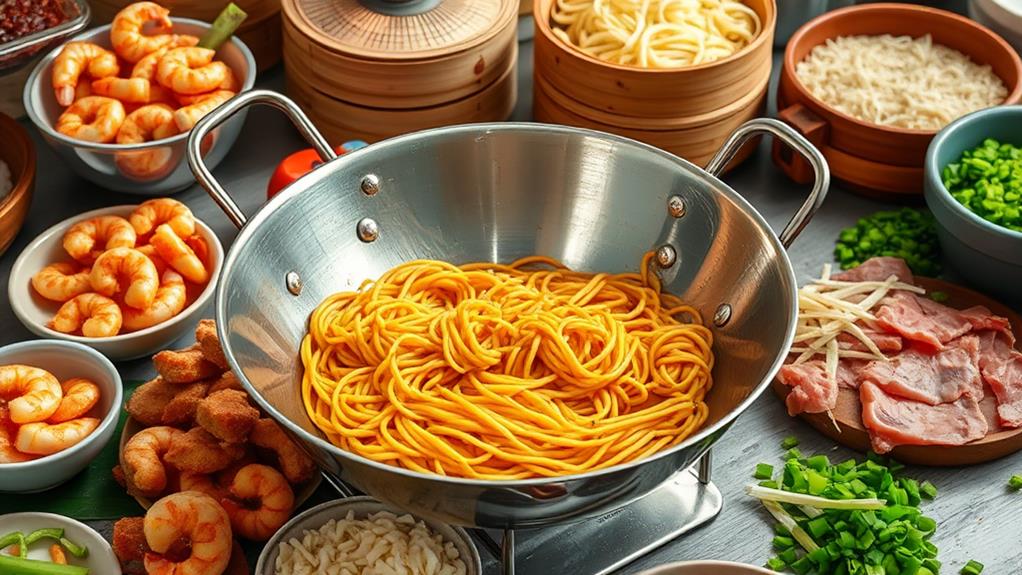
Pancit Canton's flavor profile is shaped by its combination of ingredients and cooking techniques.
The dish typically features egg noodles, stir-fried with a mix of vegetables such as carrots, bell peppers, and cabbage. Proteins like pork, chicken, or shrimp are often added to provide extra flavor and texture. Soy sauce and oyster sauce are key ingredients for seasoning, with soy sauce providing a savory depth and oyster sauce adding richness and umami.
The cooking technique plays a crucial role in achieving the desired flavor. The dish is often cooked in a wok over high heat to achieve a slight char on the noodles, enhancing the overall flavor through the Maillard reaction.
Stir-frying ingredients in stages ensures even cooking and prevents overcooking of vegetables, which should retain some crunch. Finally, garnishes like green onions, calamansi, or a fried egg on top add an extra layer of flavor and visual appeal.
Pancit in Filipino Celebrations and Identity
Pancit Canton: A Symbol of Good Fortune and Hospitality in Filipino Celebrations
Pancit Canton, a seemingly simple noodle dish, plays a significant role in Filipino gatherings and traditions. It symbolizes good fortune, longevity, and hospitality, making it an integral part of Filipino celebrations.
Family Recipes and Cultural Heritage
In Filipino culture, Pancit Canton recipes are often passed down through generations, showcasing regional variations and personal touches.
These recipes evoke a sense of nostalgia and cultural heritage, connecting families to their roots and traditions.
Communal Sharing and Togetherness
Pancit Canton is often served communally, fostering a sense of community and togetherness among family and friends.
Sharing a plate of Pancit Canton strengthens bonds and creates lasting memories, making it a staple in Filipino celebrations.
A Symbol of Honor and Respect
When served to guests, Pancit Canton is a sign of hospitality and appreciation.
It is a symbol of honor and respect, indicating that the host values the guest's presence and wishes them a long and happy life.
Through Pancit Canton, one can experience the warmth and hospitality of Filipino culture, connecting with the rich heritage and traditions that make these celebrations special.
How Has the History of Filipino Pancit Canton Influenced Its Variations?
The history of filipino pancit canton has deeply influenced its variations over time. From the Chinese laborers who introduced the dish to the Philippines to the Spanish colonial period, each era has left its mark on the flavor profile and ingredients used in different regions of the country.
Modern Twists and Future of Pancit Noodles
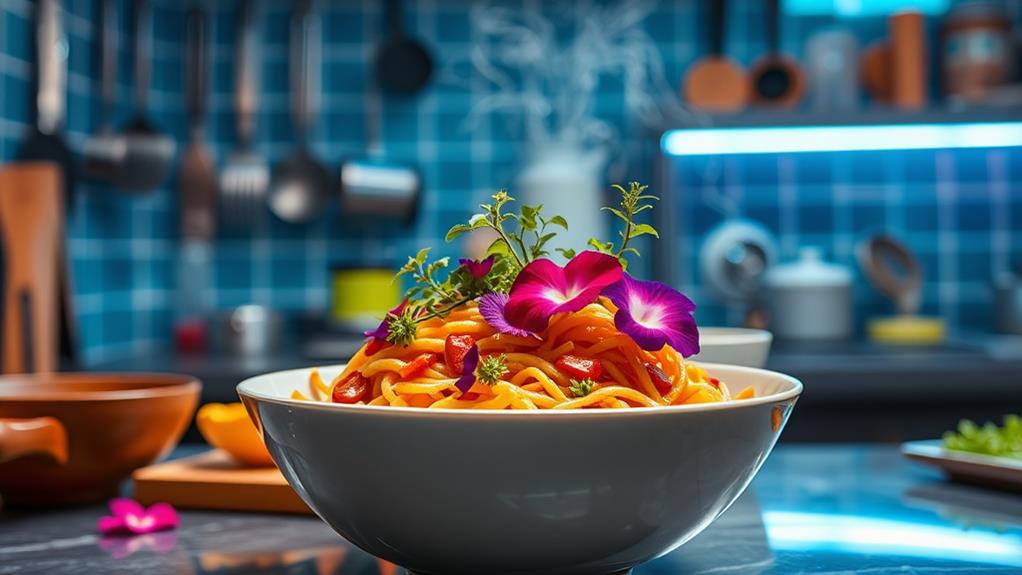
Modern Twists on Pancit Canton
Incorporating International Flavors
Pancit Canton has undergone a transformation, incorporating international flavors and ingredients to create a modern twist on this beloved dish.
Chefs are experimenting with innovative ingredients, such as truffle oil and kale, to give Pancit Canton a contemporary spin.
Catering to Diverse Dietary Needs
The rise of gluten-free alternatives has led to the development of rice flour or zucchini spiral noodles, catering to diverse dietary needs.
Fusion Cuisine Trends
Fusion cuisine trends have led to the creation of unique dishes, such as Pancit Canton tacos or burritos, showcasing the adaptability of this classic dish to different culinary styles.
Culinary Tourism and Sustainability
Culinary tourism has further highlighted Pancit Canton as a must-try dish, with local food tours focusing on regional variations and unique recipes that reflect the cultural diversity of the Philippines.
Chefs are sourcing local, seasonal ingredients to enhance flavor while supporting local farmers and promoting environmental responsibility.
Frequently Asked Questions
What Are the Different Types of Pancit?
Pancit is a diverse and rich Filipino noodle dish with various types.
There are different types of pancit, each with unique ingredients and cooking methods.
Pancit Bihon is made with thin rice vermicelli, while Pancit Malabon uses thick rice noodles.
Other variations include Pancit Palabok, which features a savory shrimp sauce, and Pancit Habhab, characterized by its tangy vinegar seasoning.
These variations showcase the creativity and cultural heritage of Filipino cuisine.
What Is the Most Popular Pancit in the Philippines?
Pancit Canton is the most popular pancit in the Philippines. This dish has spawned numerous regional specialties, each with its unique flavor profile.
For instance, in the northern regions, Pancit Canton is often served with crispy fried noodles, while in the south, it's infused with a spicy kick.
In coastal areas, seafood-packed Pancit Canton is a common variation.
The adaptability of Pancit Canton allows regional ingredients to shine while maintaining its signature savory flavor.
What Are the Different Types of Noodles in the Philippines?
The Philippines is home to a diverse array of noodles, each with its unique characteristics and cooking techniques.
Bihon noodles are delicate and slender, often used in dishes like stir-fries and soups.
Lomi noodles, on the other hand, are thick and chewy, typically served in a hot broth or with a savory sauce.
Miki noodles come in flat or round shapes and are commonly used in Filipino-Chinese dishes like pancit.
Misua noodles are thin and add texture to soups and other liquid-based dishes.
Canton noodles are egg-based and often stir-fried with vegetables and meat.
These diverse types of noodles showcase the country's rich noodle history and regional cooking traditions.
Why Is Pancit Important to the Filipino Culture?
Pancit holds immense cultural significance in Filipino culture. It symbolizes long life and prosperity, reflecting the country's rich heritage.
Historical roots in Chinese culinary traditions have been adapted to incorporate local flavors. This adaptation is a testament to the Filipino values of adaptability and creativity.
Pancit is deeply rooted in family traditions. It's often served at gatherings to promote togetherness and good fortune.
For example, in many Filipino families, pancit is a staple dish during birthdays and special celebrations, as it's believed to bring long life and good health to the celebrant.
This beloved dish embodies the Filipino values of community identity.
